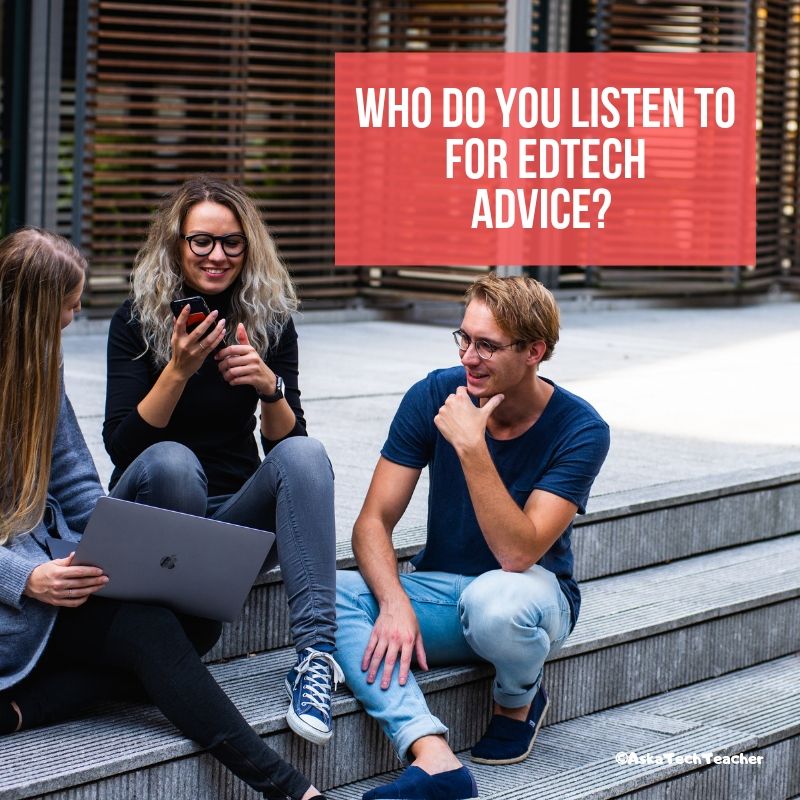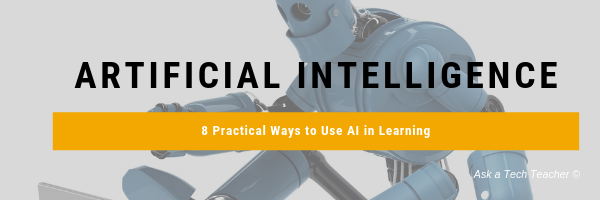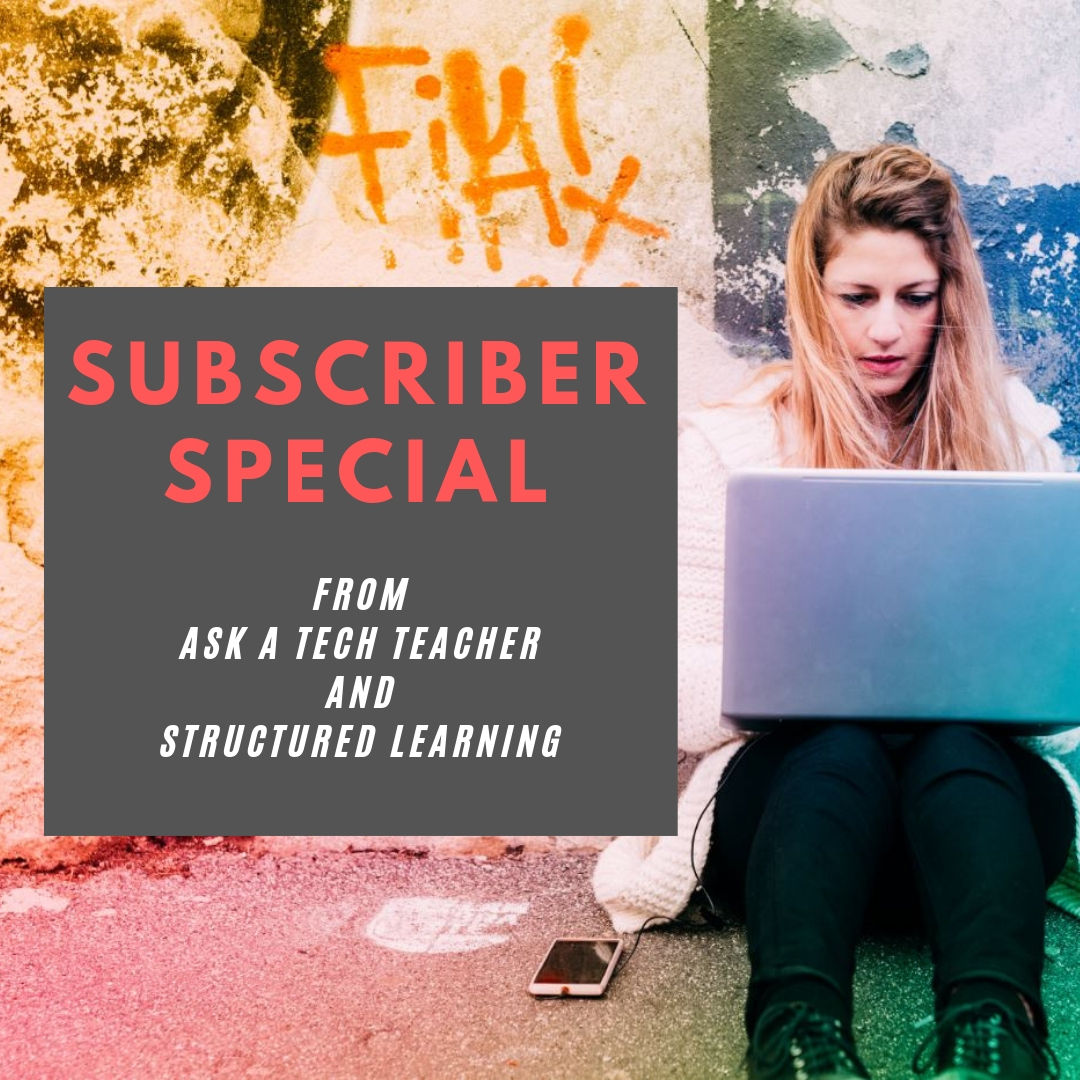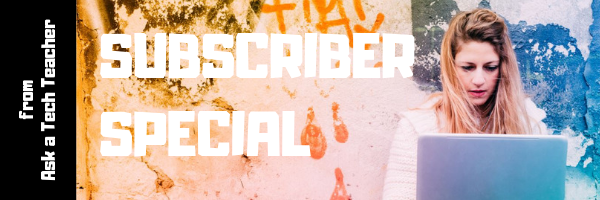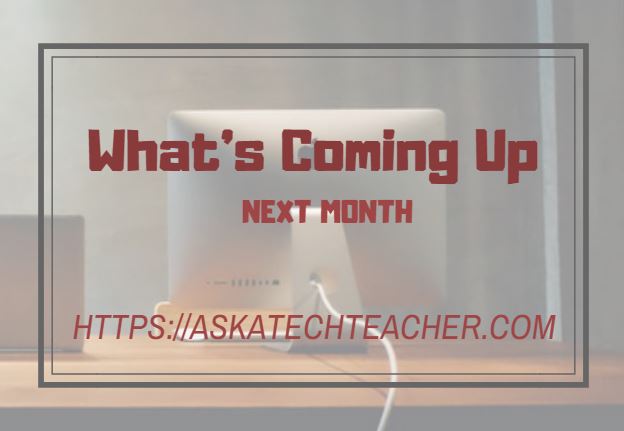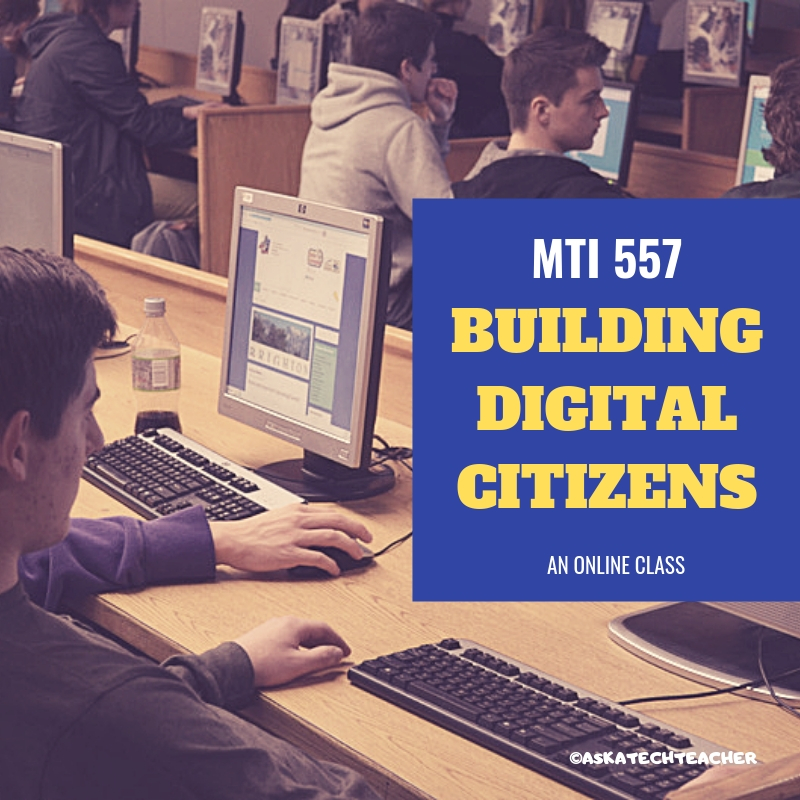Author: Jacqui
Looking for Trusted Advisers? Look No Further
Summer is the push-pull of regeneration and rejuvenation: Should I spend my summer weeks learning my craft or relaxing? Me, I have no regular winner but the more convenient learning is, the more likely I’ll squeeze a goodly quantity of learning into my vacation that serves me in the long run. Where years ago, that used to be attending a conference at an out-of-town hotel that required traveling expenses, now, I’m more likely to pick online classes. In fact, I’ve talked about these choices in other posts. Today, I want to talk about podcasts, webinars, and screencasts of knowledgeable educators who quickly can become your trusted advisors on a wide variety of education topics.
Here are my favorites:
 Alice Keeler
Alice Keeler
Blog: Teacher Tech with Alice Keeler
Books: Get Started with Google Classroom, Ditch That Homework, and more
Training: Go Slow Online Workshops, CoffeeEdu, and more
Social Media: @alicekeeler, YouTube
Alice Keeler is a Google Certified Teacher, New Media Consortium K12 Ambassador, Microsoft Innovative Educator and LEC Admin & Online and Blended certified. Professor of Curriculum, Instruction and Technology at California State University Fresno and Teacher on Special Assignment at ACEL Charter High school. She has developed and taught online K12 courses as well as the Innovative Educator Advanced Studies Certificate (cue.org/ieasc). Her goal: to inspire and help teachers to try something new. With a boatload of accolades, certifications, and followers, she is often a keynote or presenter at ISTE and CUE conferences and is the number one choice for those interested in anything Google.
Share this:
- Click to share on Facebook (Opens in new window) Facebook
- Click to share on X (Opens in new window) X
- Click to share on LinkedIn (Opens in new window) LinkedIn
- Click to share on Pinterest (Opens in new window) Pinterest
- Click to share on Telegram (Opens in new window) Telegram
- Click to email a link to a friend (Opens in new window) Email
- More
8 Practical Ways to Use AI in Learning
Every year, education finds new ways to make learning more inclusive and diversified. The latest change agent is Artificial Intelligence (AI), now being used in classes to focus learning, simplify redundant tasks, and infuse lesson plans. Ask a Tech Teacher contributor, Kamy Anderson has eight practical ways to use AI in learning:
Artificial intelligence (AI) is disrupting the education industry. Traditional classrooms may not go extinct anytime soon, but edtech will certainly change the way we learn and think about learning. It’s already challenging us, as educators, to revisit our role as sole providers of formal knowledge and professional L&D. And we must admit, AI is making things better and easier.
These are the eight practical ways to use AI in learning:
1. Smarter Content
The primary ability of AI is to collect and analyze data. Not only is this technology designed to sift through massive amounts of information but it is also ingrained with powerful curation capabilities. As a result, AI helps create smart educational content that’s being used in both classrooms and online courses. Using AI, we can deliver textbooks, lesson summaries, and flashcards that are highly focused, relevant, and applicable. Moreover, AI-empowered edtech can keep updating content with the latest findings from leading academic researchers and scientists.
Share this:
- Click to share on Facebook (Opens in new window) Facebook
- Click to share on X (Opens in new window) X
- Click to share on LinkedIn (Opens in new window) LinkedIn
- Click to share on Pinterest (Opens in new window) Pinterest
- Click to share on Telegram (Opens in new window) Telegram
- Click to email a link to a friend (Opens in new window) Email
- More
Subscriber Special: Group PD at a great price
Every month, subscribers to our newsletter get a free/discounted resource to help their tech teaching.
June 8th-10th:
Discounted Group Professional Development
Each $750 for up to 20 attendees
Pick a topic:
Tech infused Teacher/Classroom
Writing With Tech
Building Digital Citizens
20 Webtools in 20 Days
Differentiation
Share this:
- Click to share on Facebook (Opens in new window) Facebook
- Click to share on X (Opens in new window) X
- Click to share on LinkedIn (Opens in new window) LinkedIn
- Click to share on Pinterest (Opens in new window) Pinterest
- Click to share on Telegram (Opens in new window) Telegram
- Click to email a link to a friend (Opens in new window) Email
- More
What Factors Influence Your Tendency to Plagiarize in School?
I am constantly amazed at how many students plagiarize schoolwork. They feel no guilt, don’t understand the legal risk they face, and think the argument that “everyone does it” makes it OK. If you want to stop it–and every teacher I know does–you have to get at the reasons why kids think they can steal another’s work and call it their own. I was excited when Ask a Tech Teacher contributor, Milyn Anne, offered this article explaining the why behind plagiarizing:
 What Factors Influence Your Tendency to Plagiarize in School?
What Factors Influence Your Tendency to Plagiarize in School?
Plagiarism is everywhere, leading many teachers to believe that it has become a nationwide epidemic. While it’s not always easy to prevent plagiarism from occurring, knowing what factors influence a student’s tendency to plagiarize in school can help educators stay on top of this rising trend.
And if you’re a student, knowing the warning signs that may lead you astray is equally beneficial. Consider these top factors that cause students to plagiarize – and what you can do about it.
1. Psychological Factors
Many people believe that plagiarism is simply the direct cause of laziness, and while this may sometimes be true, there are underlying psychological factors that increase the likelihood of plagiarism -besides just a lack of motivation.
Here are just a few reasons why you might cheat:
- You have a fear of failure. Students who cheat often have a profound fear of failing in the classroom. They are afraid of losing their status and they may compare themselves to other students. The British Journal of Educational Psychology has produced multiple studies indicating that fear of failure determines the methods that students use to reach their goals – and that those methods often involve plagiarism. Not only that, but the fear of failure can produce other damaging psychological effects, such as a sense of hopelessness, an addiction to success, feelings of depression, and more.
- You are looking for a thrill. There is an underlying human urge to take from others what we covet for ourselves. We get a subconscious thrill when we copy others, and it releases chemicals in the brain that create feelings of happiness – chemicals like dopamine, oxytocin, serotonin, and endorphins, just to name a few.
- You are overly confident. This may sound contradictory, but students with overly large egos may be tempted to cheat because they think that either nobody will catch them or, if they do, they will be above any potential consequences. You might think there is nothing wrong with plagiarism or possess a false sense of security.
Share this:
- Click to share on Facebook (Opens in new window) Facebook
- Click to share on X (Opens in new window) X
- Click to share on LinkedIn (Opens in new window) LinkedIn
- Click to share on Pinterest (Opens in new window) Pinterest
- Click to share on Telegram (Opens in new window) Telegram
- Click to email a link to a friend (Opens in new window) Email
- More
5 Favorite Apps for Summer Learning
 Summer has a reputation for being nonstop relaxation, never-ending play, and a time when students stay as far from “learning” as they can get. For educators, those long empty weeks result in a phenomenon known as “Summer Slide” — where students start the next academic year behind where they ended the last.
Summer has a reputation for being nonstop relaxation, never-ending play, and a time when students stay as far from “learning” as they can get. For educators, those long empty weeks result in a phenomenon known as “Summer Slide” — where students start the next academic year behind where they ended the last.
“…on average, students’ achievement scores declined over summer vacation by one month’s worth of school-year learning…” (Brookings)
This doesn’t have to happen. Think about what students don’t like about school. Often, it revolves around repetitive schedules, assigned grades, and/or being forced to take subjects they don’t enjoy. In summer, we can meet students where they want to learn with topics they like by offering a menu of ungraded activities that are self-paced, exciting, energizing, and nothing like school learning. We talk about life-long learners (see my article on life-long learners). This summer, model it by offering educational activities students will choose over watching TV, playing video games, or whatever else they fall into when there’s nothing to do.
Here are favorites that my students love:
Share this:
- Click to share on Facebook (Opens in new window) Facebook
- Click to share on X (Opens in new window) X
- Click to share on LinkedIn (Opens in new window) LinkedIn
- Click to share on Pinterest (Opens in new window) Pinterest
- Click to share on Telegram (Opens in new window) Telegram
- Click to email a link to a friend (Opens in new window) Email
- More
Last Chance for this College-credit Class (563–Differentiation)
MTI 563: The Differentiated Teacher
MTI 563 starts in one week–Monday, June 10, 2019! Click this link; scroll down to MTI 563 and click for more information and to sign up.
What is it
Differentiation in the classroom means meeting students where they are most capable of learning. It is not an extra layer of work, rather a habit of mind for both teacher and student. Learn granular approaches to infusing differentiation into all of your lesson plans, whether you’re a Common Core school or not, with this hands-on, interactive class. Ideas include visual, audio, video, mindmaps, infographics, graphic organizers, charts and tables, screenshots, screencasts, images, games and simulations, webtools, and hybrid assessments.
Assessment is based on involvement, interaction with classmates, and completion of projects so be prepared to be fully-involved and an eager risk-taker. Price includes course registration, college credit, and all necessary materials. To enroll, click the link above, search for MTI 563 and sign up. Email askatechteacher at gmail dot com for questions.
Share this:
- Click to share on Facebook (Opens in new window) Facebook
- Click to share on X (Opens in new window) X
- Click to share on LinkedIn (Opens in new window) LinkedIn
- Click to share on Pinterest (Opens in new window) Pinterest
- Click to share on Telegram (Opens in new window) Telegram
- Click to email a link to a friend (Opens in new window) Email
- More
Wonderful Southeast Asia Trip!
 I am finally back from my international trip where I visited three areas, four hotels, and took a gazillion trains. The background: My daughter and I went to Okinawa Japan where my son is stationed with the Army to celebrate his birthday and decided to also visit the main island of Japan and South Korea. This post won’t be a travelogue but I am happy to say we had tremendous fun. I rarely travel internationally–the last time was when I toured the Soviet Union (now Russia et al)–so didn’t know what to expect as far as languages, customs, foreign money, and everything in between. Words can’t express how nervous the whole thing made me (I’m not a brave person) but with my kids’ support, I did it and am happy I did.
I am finally back from my international trip where I visited three areas, four hotels, and took a gazillion trains. The background: My daughter and I went to Okinawa Japan where my son is stationed with the Army to celebrate his birthday and decided to also visit the main island of Japan and South Korea. This post won’t be a travelogue but I am happy to say we had tremendous fun. I rarely travel internationally–the last time was when I toured the Soviet Union (now Russia et al)–so didn’t know what to expect as far as languages, customs, foreign money, and everything in between. Words can’t express how nervous the whole thing made me (I’m not a brave person) but with my kids’ support, I did it and am happy I did.
A few highlights:
- We planned to carry on our luggage and do laundry in the hotels. That often didn’t work as there were strictly-enforced weight limits on flights.
- We traveled Delta’s Comfort Plus to and from Japan. This cost more money than Main Cabin but much less than Business Class and turned out to be a wonderful balance of cost and comfort. Check it out next time you take a nine-hour flight.
- I worried about phone charges but that was solved by leaving my phone in Airplane Mode the entire time. Luckily, my son had local phone service so we used his.
- We stayed in US Military vacation housing. This is discounted luxury hotels they make available to Active and Retired military. It had everything I needed at a fourth of the price.
- I bought a Scottevest for the trip with its dozen pockets and RFID protection for carrying my passport, military base passes, wallet, receipts, room keys, phone, headphones, rechargers, medication info, and incidentals. It was a life saver.
- The first thing I noticed as I arrived in Narita (the Japanese airport that was our port of entry) was how quiet the terminal was. The people didn’t chatter endlessly as Americans do. That changed when we arrived at Customs and Immigration, thanks to all the foreigners.
- Japan and South Korea have few trash cans and still no trash lying around on streets, on trains, on sidewalks. It seems that no one tosses their refuse on the ground. I ended carrying mine around until I came across the rare trash can or a restroom.
- Japanese trains are clean, well-maintained, safe, dependable, affordable, and packed with riders.
- As one who speaks neither Japanese or Korean, I gained an appreciation for symbols and hand motions. Most signs included a visual of what they meant which was all that save me from complete confusion many times.
- The Japanese walk everywhere and do it quickly. Many people older than me passed me up and climbed multiple levels of stairs without slowing down (by the thrid flight, I was stopping to rest). I tracked my steps and floors on a health app and I often exceeded 17,000 steps and over 40 floors. Yikes!
- There are trains to take you anywhere you need. Most people don’t commute to work in cars and taxis are horrendously expensive. But, once again–these folks don’t mind walking. The train we’d take to our tours were always at least a half mile from our hotel. Lots and lots and lots of walking.
- Many restaurants didn’t offer napkins with the meal. When we asked at one of the eateries, they gave us a box of Kleenex because that was all she had.
- I ate 50% more food than normal and lost one pound. Woot!
A few problems–not unexpected on a long international trip:
Share this:
- Click to share on Facebook (Opens in new window) Facebook
- Click to share on X (Opens in new window) X
- Click to share on LinkedIn (Opens in new window) LinkedIn
- Click to share on Pinterest (Opens in new window) Pinterest
- Click to share on Telegram (Opens in new window) Telegram
- Click to email a link to a friend (Opens in new window) Email
- More
Here’s a Preview of June
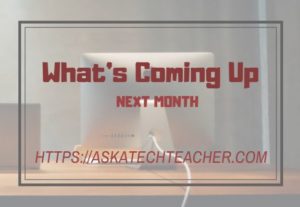 Here’s a preview of what’s coming up on Ask a Tech Teacher in July:
Here’s a preview of what’s coming up on Ask a Tech Teacher in July:
- the June Subscriber Special
- World Environment Day
- Online College Class Starting
- 10 Books You’ll Want to Read This Summer
- 5 Favorite Apps for Summer Learning
- 8 Practical Ways to Use AI in Learning
- Looking for Trusted ADvisers? Look No Further
- 11 Bits of Wisdom I Learning From a Computer (humor)
- 8 Tech Tools for PE Teachers
- What is Constructivism?
- 12 Great Virtual REality Apps
- Videos for Education
- What’s Changed in Lesson Planning
- Curriculum-based Assessments
- 4 Innovative Ways to Co-author a Book
Share this:
- Click to share on Facebook (Opens in new window) Facebook
- Click to share on X (Opens in new window) X
- Click to share on LinkedIn (Opens in new window) LinkedIn
- Click to share on Pinterest (Opens in new window) Pinterest
- Click to share on Telegram (Opens in new window) Telegram
- Click to email a link to a friend (Opens in new window) Email
- More
Last Chance for this College-credit Class (557)
MTI 557: Building Digital Citizens
Starts Monday, June 3, 2019! Last chance to sign up. Click this link; scroll down to MTI 557 and click for more information and to sign up.
If students use the internet, they must be familiar with the rights and responsibilities required to be good digital citizens. In this class, you’ll learn what topics to introduce, how to unpack them, and how to make them authentic to student lives.
Topics include:
- copyrights, fair use, public domain
- cyberbullying
- digital commerce
- digital communications
- digital footprint, digital privacy
- digital rights and responsibilities
- digital search/research
- image—how to use them legally
- internet safety
- netiquette
- passwords
- plagiarism
- social media
At the completion of this course, you will be able to:
- Know how to blend digital citizenship into lesson plans that require the Internet
- Be comfortable in your knowledge of all facets of digital citizenship
- Become an advocate of safe, legal, and responsible use of online resources
- Exhibit a positive attitude toward technology that supports learning
- Exhibit leadership in teaching and living as a digital citizen
Assessment is based on involvement, interaction with classmates, and completion of projects so be prepared to be fully-involved and an eager risk-taker. Price includes course registration, college credit, and all necessary materials.
To enroll, click the link above, search for MTI 557 and sign up. Need help? Email askatechteacher@gmail.com for upcoming dates.
Share this:
- Click to share on Facebook (Opens in new window) Facebook
- Click to share on X (Opens in new window) X
- Click to share on LinkedIn (Opens in new window) LinkedIn
- Click to share on Pinterest (Opens in new window) Pinterest
- Click to share on Telegram (Opens in new window) Telegram
- Click to email a link to a friend (Opens in new window) Email
- More
I’m Traveling!
May 11th-24th
I’m taking a trip with my daughter to visit my son who is stationed in Okinawa with the Army. We’ll spend two weeks traveling the area. I haven’t done this in fifty years (when I traveled through the old Soviet Union and Europe) and am beyond excited!
Share this:
- Click to share on Facebook (Opens in new window) Facebook
- Click to share on X (Opens in new window) X
- Click to share on LinkedIn (Opens in new window) LinkedIn
- Click to share on Pinterest (Opens in new window) Pinterest
- Click to share on Telegram (Opens in new window) Telegram
- Click to email a link to a friend (Opens in new window) Email
- More

